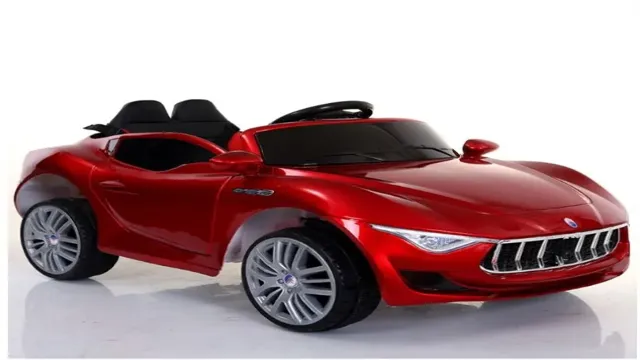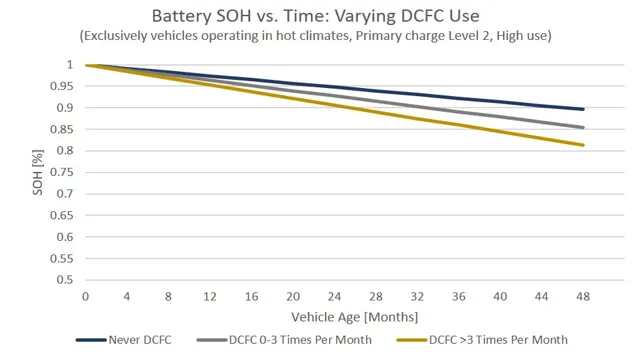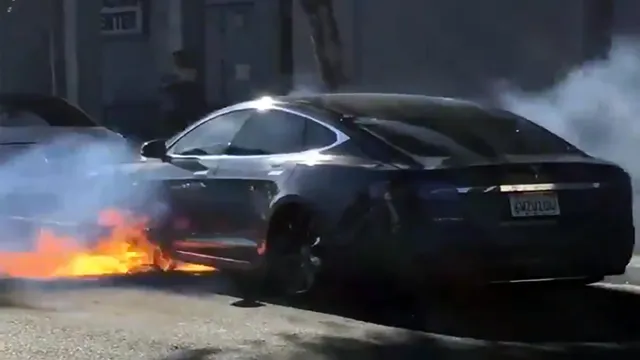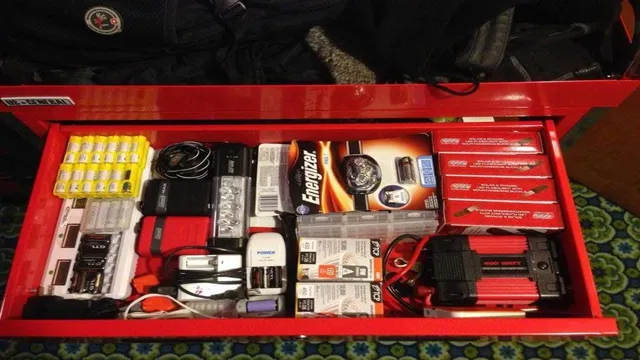Power Up Playtime: A Comprehensive Guide to Children’s Electric Car Batteries
Are you tired of constantly replacing the batteries in your child’s electric car? It’s no secret that electric cars for kids are becoming increasingly popular, but with so many options available, it can be difficult to know which batteries are the best. Luckily, we’ve got you covered with the ultimate guide to children’s electric car batteries. First and foremost, it’s important to understand the different types of batteries available.
Most electric cars for children come equipped with either lead-acid or lithium-ion batteries. Lead-acid batteries tend to be less expensive but also have a shorter lifespan and longer charging time. On the other hand, lithium-ion batteries are more expensive but offer a longer lifespan, shorter charging time, and better performance.
When choosing a battery, it’s also important to consider the voltage and capacity. Voltage determines the speed of the car, while capacity determines how long the battery will last. It’s essential to select a battery with the appropriate voltage and capacity for your child’s age and weight.
Lastly, always make sure to properly maintain and store your electric car battery. This includes cleaning the battery regularly, avoiding extreme temperatures, and storing the battery in a cool, dry place when not in use. By following these guidelines, you can ensure that your child’s electric car battery lasts longer and provides a safe and enjoyable ride.
Invest in the right battery, and you’ll be on your way to hours of uninterrupted playtime.
Types of Electric Car Batteries for Kids
If you’re looking for an electric car battery for your kid, there are several options available. One type of children’s electric car battery is the lead-acid battery. These are the most common type of batteries used in electric ride-on vehicles and are affordable, reliable, and durable.
Another option is the nickel-metal hydride battery, which is more energy-dense and efficient than lead-acid batteries, but can be more expensive. Lithium-ion batteries are another popular choice due to their high energy density, long lifespan, and quick charging times. However, they can also be the most expensive option.
Ultimately, the type of battery you choose will depend on your budget and the specific needs of your child. Regardless of the type of battery, make sure to always follow proper charging and safety guidelines to ensure your child’s electric car runs safely and smoothly.
Lead Acid Batteries
Lead Acid Batteries Electric cars for kids are gaining immense popularity nowadays, and for good reason. They help children develop their motor skills and increase their hand-eye coordination while providing a sense of fun and excitement. However, before investing in an electric car for your child, it’s essential to know the different types of batteries used to power these vehicles.
One commonly used battery is the lead-acid battery. These batteries are affordable and reliable, making them perfect for kids’ electric cars. They are known for their durability, efficiency, and ability to withstand harsh conditions.
On the downside, lead-acid batteries also have some drawbacks, such as their weight, size, and low energy density, which means they require frequent charging and take longer to recharge. Nonetheless, if you’re on a budget and looking for a reliable option, lead-acid batteries are definitely worth considering.

Lithium-ion Batteries
One of the most common types of electric car batteries for kids is the lithium-ion battery. They are widely used in electric cars due to their high energy density, which means they can store large amounts of energy in a relatively small space. Lithium-ion batteries are also known for their long lifespan and high efficiency, making them ideal for powering electric cars.
These batteries use lithium ions to store and release energy, making them lightweight and easy to handle. However, they do require proper maintenance to ensure their longevity, such as keeping them at the right temperature and avoiding overcharging. All in all, the lithium-ion battery is a reliable and efficient option for electric car batteries for kids, providing a fun and eco-friendly way to play and learn.
Factors to Consider When Buying an Electric Car Battery for Kids
If you’re looking for a children’s electric car battery, there are a few key factors to consider before making a purchase. Firstly, you’ll want to think about the size and weight of the battery, as this will impact the overall performance of the car. Ideally, you’ll want a battery that is small and lightweight enough for your child to operate easily, but also powerful enough to keep the car moving smoothly.
Secondly, you’ll want to consider the battery’s lifespan and charging time. Depending on how often your child will be using the car, you may prefer a battery that can hold a charge for longer periods of time, or one that can be charged quickly and easily. Additionally, you’ll want to ensure that the battery is compatible with the specific model of electric car you’re purchasing, as not all batteries will work with all cars.
Lastly, you’ll want to be mindful of the battery’s safety features, such as built-in overheating protection or short circuit prevention, to ensure that your child stays safe while playing with their electric car. By taking these factors into account, you can find the perfect battery to power your child’s electric car and provide hours of entertainment and fun.
Battery Life and Capacity
When it comes to buying an electric car battery for kids, there are many factors to consider. One of the most important factors is battery life and capacity. This refers to how long the battery will last on a single charge and how much energy it can store.
A larger battery capacity will allow for longer playtime before needing to recharge, while a shorter battery life may mean more frequent charging. Additionally, the type of battery used can influence overall performance. Lithium-ion batteries are a popular choice as they provide a high energy density and longer lifespan than other types of batteries.
When choosing an electric car battery for kids, it’s important to find a balance between battery life, capacity, and performance that suits the specific needs of your child and how they like to play.
Safety Features
When it comes to buying an electric car battery for kids, safety features should be a top priority. After all, your child’s well-being should always come first. Look for batteries that come with built-in safety mechanisms such as overcharge protection and short circuit prevention.
It’s also important to choose a battery with the appropriate voltage and capacity for your child’s electric car. If the battery is too powerful, it could pose a safety risk, and if it doesn’t have enough capacity, your child might not be able to drive their car for very long. So, make sure to do your research and consider all the factors before making a purchase.
By doing so, you’ll be providing your child with a fun, safe, and long-lasting electric car experience.
Compatibility with the Car
When buying an electric car battery for kids, it’s important to consider the compatibility of the battery with the car. There are several factors to keep in mind when selecting a battery that matches the specifications of the car. One of the key things to consider is the voltage of the battery.
This needs to match the requirements of the car, as a battery with too low a voltage may not be powerful enough to run the car, while a battery with too high a voltage can be dangerous. Additionally, it’s important to think about the size of the battery and whether it will fit in the car’s battery compartment. Some batteries may be too large or heavy for the car, making them impractical or even impossible to use.
By paying attention to these details, you can ensure that the battery you choose will be compatible with the car and provide your child with a fun and safe driving experience.
Tips for Maintaining Electric Car Batteries for Kids
When it comes to children’s electric car batteries, proper maintenance can help prolong their lifespan and overall performance. One key tip is to always ensure the battery is fully charged before use. This not only allows for longer driving time but also helps prevent over-discharging, which can damage the battery.
It’s also important to regularly clean the battery terminals and connectors to prevent corrosion buildup, as this can impede proper electrical flow. When storing the car, it’s best to remove the battery and store it separately in a cool, dry place. This helps prevent damage from extreme temperatures or humidity.
Overall, taking care of the battery will not only provide a better driving experience for your child but also save you money in the long run by avoiding premature replacements.
Regular Charging and Discharging
Maintaining electric car batteries for kids is crucial to ensure their longevity and optimal performance. Regular charging and discharging of the battery is one of the most important ways to maintain it. It is essential to charge the battery fully and not overcharge it as it can damage the battery’s health.
Similarly, discharging the battery fully or not using it for a long time can also adversely affect its health. Therefore, it is recommended to charge the battery periodically even if the car is not in use. This keeps the battery health intact and helps it to perform efficiently for a long time.
Kids can be taught to be mindful of the battery level and charge it frequently to avoid overheating or over-discharging, which can cause long-term damage to the battery. Storing the electric car in cool and dry places and avoiding exposure to extreme temperatures also go a long way in maintaining the battery’s health. Overall, regular charging and discharging, along with proper storage and temperature control, can help maintain electric car batteries for kids and ensure they enjoy their rides for a long time.
Proper Storage and Temperature Control
Proper storage and temperature control are crucial factors for maintaining the longevity and performance of electric car batteries for kids. One important tip is to always keep the battery at a moderate temperature – not exposing it to extreme heat or cold, as this can cause damage or discharge. Additionally, storing the battery in a dry place away from moisture is key to preventing corrosion.
When not in use, make sure to keep the battery charged regularly, as letting it run too low can cause irreversible damage. Finally, invest in a quality charger that is compatible with your battery to ensure safe and efficient charging. By following these simple guidelines, you can ensure that your child’s electric car battery is well-maintained and ready to go when they are.
Conclusion: Choosing the Best Electric Car Battery for Your Child
In conclusion, the children’s electric car battery is like the little engine that could. It powers young drivers on exciting adventures, allowing them to explore new worlds and fuel their imaginations. Just like how the battery needs to be recharged, it’s important for all of us to take a break and recharge our own batteries.
Who knows, maybe one day these mini drivers will grow up to create the next big innovation in electric car technology!”
FAQs
What age group is suitable for children’s electric car battery?
Children’s electric car battery is suitable for children aged 3-8 years.
Can children’s electric car battery run on other types of battery?
No, children’s electric car battery is specifically designed to run on rechargeable battery packs.
How long does it take to charge the battery of children’s electric car?
It takes around 8-12 hours to fully charge the battery of children’s electric car.
Is it safe for children to drive electric cars with a battery?
Yes, it is safe for children to drive electric cars with a battery as long as parental supervision is provided and safety precautions are followed.
Can the battery of children’s electric car be replaced or upgraded?
Yes, the battery of children’s electric car can be replaced or upgraded, but it is recommended to consult the manufacturer or a professional technician for proper installation.




